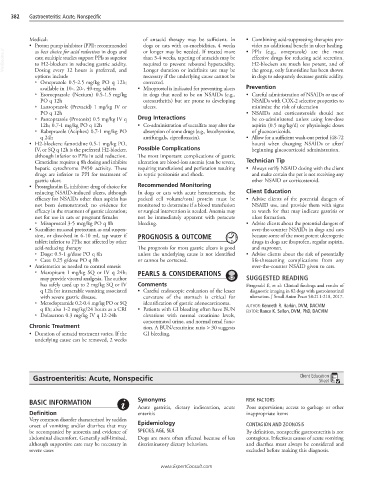Page 805 - Cote clinical veterinary advisor dogs and cats 4th
P. 805
382 Gastroenteritis: Acute, Nonspecific
Medical: of antacid therapy may be sufficient. In • Combining acid-suppressing therapies pro-
vides no additional benefit in ulcer healing.
• Proton pump inhibitor (PPI): recommended dogs or cats with co-morbidities, 4 weeks • PPIs (e.g., omeprazole) are the most
VetBooks.ir cats; multiple studies support PPIs as superior than 3-4 weeks, tapering of antacids may be effective drugs for reducing acid secretion.
or longer may be needed. If treated more
as best choice for acid reduction in dogs and
required to prevent rebound hyperacidity.
to H2-blockers in reducing gastric acidity.
H2-blockers are much less potent, and of
Dosing every 12 hours is preferred, and
options include Longer duration or indefinite use may be the group, only famotidine has been shown
necessary if the underlying cause cannot be
in dogs to adequately decrease gastric acidity.
○ Omeprazole 0.5-2.5 mg/kg PO q 12h; corrected.
available in 10-, 20-, 40-mg tablets • Misoprostol is indicated for preventing ulcers Prevention
○ Esomeprazole (Nexium) 0.5-1.5 mg/kg in dogs that need to be on NSAIDs (e.g., • Careful administration of NSAIDs or use of
PO q 12h osteoarthritis) but are prone to developing NSAIDs with COX-2 selective properties to
○ Lansoprazole (Prevacid) 1 mg/kg IV or ulcers. minimize the risk of ulceration
PO q 12h • NSAIDs and corticosteroids should not
○ Pantoprazole (Protonix) 0.5 mg/kg IV q Drug Interactions be co-administered unless using low-dose
12h; 0.7-1 mg/kg PO q 12h • Co-administration of sucralfate may alter the aspirin (0.5 mg/kg/d) or physiologic doses
○ Rabeprazole (Aciphex) 0.7-1 mg/kg PO absorption of some drugs (e.g., levothyroxine, of glucocorticoids.
q 24h antifungals, ciprofloxacin). • Allow for a sufficient wash-out period (48-72
• H2-blockers: famotidine 0.5-1 mg/kg PO, hours) when changing NSAIDs or after/
IV, or SQ q 12h is the preferred H2-blocker, Possible Complications beginning glucocorticoid administration.
although inferior to PPIs in acid reduction. The most important complications of gastric
Cimetidine requires q 8h dosing and inhibits ulceration are blood-loss anemia (can be severe, Technician Tip
hepatic cytochrome P450 activity. These requiring transfusions) and perforation resulting • Always verify NSAID dosing with the client
drugs are inferior to PPI for treatment of in septic peritonitis and shock. and make certain the pet is not receiving any
gastric ulcer. other NSAID or corticosteroid.
• Prostaglandin E 2 inhibitor: drug of choice for Recommended Monitoring
reducing NSAID-induced ulcers, although In dogs or cats with acute hematemesis, the Client Education
efficacy for NSAIDs other than aspirin has packed cell volume/total protein must be • Advise clients of the potential dangers of
not been demonstrated; no evidence for monitored to determine if a blood transfusion NSAID use, and provide them with signs
efficacy in the treatment of gastric ulceration; or surgical intervention is needed. Anemia may to watch for that may indicate gastritis or
not for use in cats or pregnant females not be immediately apparent with peracute ulcer formation.
○ Misoprostol 3-5 mcg/kg PO q 8h bleeding. • Advise clients about the potential dangers of
• Sucralfate: mucosal protectant; as oral suspen- over-the-counter NSAIDs in dogs and cats
sion, or dissolved in 6-10 mL tap water if PROGNOSIS & OUTCOME because some of the most potent ulcerogenic
tablet; inferior to PPIs; not affected by other drugs in dogs are ibuprofen, regular aspirin,
acid-reducing therapy The prognosis for most gastric ulcers is good and naproxen.
○ Dogs: 0.5-1 g/dose PO q 8h unless the underlying cause is not identified • Advise clients about the risk of potentially
○ Cats: 0.25 g/dose PO q 8h or cannot be corrected. life-threatening complications from any
• Antiemetics as needed to control emesis over-the-counter NSAID given to cats.
○ Maropitant 1 mg/kg SQ or IV q 24h; PEARLS & CONSIDERATIONS
may provide visceral analgesia. The author SUGGESTED READING
has safely used up to 2 mg/kg SQ or IV Comments Fitzgerald E, et al: Clinical findings and results of
q 12h for intractable vomiting associated • Careful endoscopic evaluation of the lesser diagnostic imaging in 82 dogs with gastrointestinal
with severe gastric disease. curvature of the stomach is critical for ulceration. J Small Anim Pract 58:211-218, 2017.
○ Metoclopramide 0.2-0.4 mg/kg PO or SQ identification of gastric adenocarcinoma.
q 8h; also 1-2 mg/kg/24 hours as a CRI • Patients with GI bleeding often have BUN AUTHOR: Kenneth R. Harkin, DVM, DACVIM
EDITOR: Rance K. Sellon, DVM, PhD, DACVIM
○ Dolasetron 0.3 mg/kg IV q 12-24h elevations with normal creatinine levels,
concentrated urine, and normal renal func-
Chronic Treatment tion. A BUN/creatinine ratio > 30 suggests
• Duration of antacid treatment varies. If the GI bleeding.
underlying cause can be removed, 2 weeks
Gastroenteritis: Acute, Nonspecific Client Education
Sheet
BASIC INFORMATION Synonyms RISK FACTORS
Acute gastritis, dietary indiscretion, acute Poor supervision; access to garbage or other
Definition enteritis inappropriate items
Very common disorder characterized by sudden Epidemiology
onset of vomiting and/or diarrhea that may CONTAGION AND ZOONOSIS
be accompanied by anorexia and evidence of SPECIES, AGE, SEX By definition, nonspecific gastroenteritis is not
abdominal discomfort. Generally self-limited, Dogs are more often affected because of less contagious. Infectious causes of acute vomiting
although supportive care may be necessary in discriminatory dietary behaviors. and diarrhea must always be considered and
severe cases excluded before making this diagnosis.
www.ExpertConsult.com

